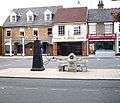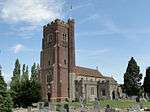Rochford
| Rochford | |
 Rochford |
|
| Population | 8,471 (2011 census)[1] |
|---|---|
| OS grid reference | TQ876904 |
| District | Rochford |
| Shire county | Essex |
| Region | East |
| Country | England |
| Sovereign state | United Kingdom |
| Post town | Rochford |
| Postcode district | SS4 |
| Dialling code | 01702 |
| Police | Essex |
| Fire | Essex |
| Ambulance | East of England |
| EU Parliament | East of England |
| UK Parliament | Rochford and Southend East |
Coordinates: 51°34′56″N 0°42′23″E / 51.5821°N 0.7065°E
Rochford is a town in the Rochford district of Essex in the East of England. It is about 43 miles (69 km) from Central London and approximately 21 miles (34 km) from Chelmsford, the County Town of Essex. According to the 2001 census the civil parish of Rochford, which includes the town proper, and London Southend Airport, had a population of 7,610, increasing to 8,471 at the 2011 Census.[1]
History
The town is the main settlement in the Rochford district, and takes its name from Rochefort, Old English for Ford of the Hunting Dogs. The River Roach was originally called the Walfleet (Creek of the foreigners). It was renamed the Roach in what is known as a back formation. This is where it is assumed that Rochford means ford over the River Roach so they renamed the river to fit the theory. The town runs into suburban developments in the parishes of Ashingdon and Hawkwell. Kings Hill, in Rochford, was notable for containing the Lawless Court up until the 19th century.[2]
Peculiar People
In 1837 John Banyard (a reformed drunk and Wesleyan preacher) and William Bridges took a lease on the old workhouse at Rochford, which became the first chapel of the Peculiar People, a name taken from Deuteronomy 14:2 and 1 Peter 2:9. The Peculiar People practised a lively form of worship bound by the literal interpretation of the King James Bible, banning both frivolity and medicine. During the two World Wars some were conscientious objectors, believing that war is contrary to the teachings of Jesus Christ. The Peculiar People are nowadays known as the Union of Evangelical Churches, and have two churches in London and thirteen in Essex.
John Banyard was buried in the graveyard of St Andrew's, Rochford.
First World War
Nearby Southend Airport started life as a grass fighter station in World War I.[3] The site was founded in the autumn of 1914 when farmland between Westbarrow Hall and the Great Eastern railway line at Warners Bridge 2½ miles north of Southend Pier was acquired for RFC training purposes. Training continued until May 1915 when the site, known also as Eastwood, was taken over by the RNAS to become a Station (night) in the fight against intruding Zeppelins.
Second World War
Southend Airport was opened on the site on 18 September 1935. As World War II approached it was requisitioned by the Air Ministry in August 1939[4] for use as a fighter airfield by No.11 Group RAF. RAF Rochford was a satellite station for RAF Hornchurch and was primarily a fighter base, home mainly to Supermarine Spitfire and Hawker Hurricane aircraft. Rochford airfield was accompanied by a radar base in Canewdon (around 4 miles (6.4 km) away). Due to the presence of the airfield Rochford was bombed a number of times during the war.
It was returned to civilian service on 31 December 1946.[5]
Lesneys
Until the early 1980s one of the largest employers in Rochford was the Lesneys factory, who manufactured the famous Matchbox miniature die cast model. However this factory closed in 1987.[6]
Geography
The town is just to the north of Southend on Sea, but is sufficiently separated from both Southend and Rayleigh to preserve its own identity .
Governance
The Member of Parliament for Rochford and Southend East is James Duddridge (Conservative). An electoral ward in the same name exists. At the 2011 Census this ward had a population of 7,695.[7]
Landmarks
Rochford Hall is partly privately owned by a family which live within the building, along with the golf course who also own a part of it as their clubhouse. In 1525, Henry VIII awarded Thomas Boleyn the title of Viscount Rochford. Rochford Hall subsequently became the home of Mary Boleyn, sometime mistress of Henry VIII and (probably elder) sister of Queen Anne Boleyn, during Mary's second marriage to Sir William Stafford.
Leisure
Rochford Council are in partnership with Virgin Active in running Clements Hall Leisure Centre and Rayleigh Leisure Centre.
Sport
Rochford Hundred Rugby Union Club was formed in 1962 and as of 2016-17 play in London League 1 North.[8]
Transport
Rochford railway station from which trains run to Southend Victoria and to Liverpool Street station in the business district of central London. In consequence it has long been popular as a dormitory town for commuters. Southend Airport railway station on the eastern boundary of the airport, opened on 18 July 2011.
It also has good bus links to the surrounding towns. The Number 7, 8 and 9 service going to both Rayleigh and Southend-on-Sea.
There are over twenty scheduled flight destinations within Europe available from London Southend Airport.
Rochford Hospital
Rochford Hospital used to be primarily the district maternity hospital. It was here, in 1956, that Sister J Ward made observations that led to the development of phototherapy for newborns suffering from jaundice.[9]
Rochford Hospital was officially opened on Thursday 7 May 2009 by Professor Louis Appleby.
Churches
St Andrew's Church, Rochford, is close to Rochford Hall, and is part of Rochford Deanery,[10] within the Bradwell Area[11] of the Church of England Diocese of Chelmsford.[12]
Rochford Congregational Church has been part of the local community since 1750. The Congregational Church also established the first Dissenting School in the area; When others were afraid of educating the children of the lower classes because they might prove a danger to the state, the church ensured that ordinary people had "a plain and useful education." [13]
Rochford Methodist Church, near the White Horse Public House. The Methodists have been in Rochford since 1822, originally meeting in a building where Market Alley turns into the Square. In 1841 they moved to a new building in North Street near Weir Pond Road, and in 1880 they moved to their current premises.[14]
Rochford Community Church was founded in 1987 and meets at The Freight House near the railway station.[15]
There is also a small Roman Catholic church in Rochford, St Teresa of the child Jesus.[16]
Notable people
- Jamie Cullum, jazz-pop musician
- Terry Alderton, comedian and former footballer
- Peter Allen, journalist and radio presenter
- Digby Fairweather, jazz musician
- Brenda Forbes, Anglo-American actress of stage and screen
- Philip Guard, actor
- Dean Macey, athlete
- Mike Penning, Conservative MP
- Richard Rich, 1st Baron Rich, Lord Chancellor under Edward VI, died in Rochford 12 June 1567
- Rachel Riley, TV presenter and mathematician, born in Rochford but raised in Thorpe Bay, Southend-on-Sea
- Will Stevens, racing driver[17]
- Amanda Tapping, actress, producer and director best known for playing Dr./Captain/Major/Lieutenant Colonel/Colonel Samantha "Sam" Carter on the Canadian/American sci-fi shows, "Stargate SG-1", "Stargate Atlantis" and "Stargate Universe" was born in Rochford before moving to Canada with her family.
- Andrew Tyrie, Conservative MP
- Omar Abdullah, Chief Minister, Jammu and Kashmir, India
- James Bourne, Singer and guitarist for band McBusted
Gallery
 Town Square, Rochford
Town Square, Rochford Aerial photo over Rochford. The old hospital boilerhouse can be seen.
Aerial photo over Rochford. The old hospital boilerhouse can be seen. Rochford Hall, Rochford
Rochford Hall, Rochford St Andrew's Church, Rochford
St Andrew's Church, Rochford
References
| Wikimedia Commons has media related to Rochford. |
- 1 2 "Civil parish population 2011". Neighbourhood Statistics. Office for National Statistics. Retrieved 24 September 2015.
- ↑ Kenny, Courtney (1905). "The Lawless Court of Essex". Columbia Law Review. Columbia Law School. 5 (7): 529. doi:10.2307/1109762. ISSN 0010-1958.
- ↑ Southend Airport.net
- ↑ UK Cold War.org.uk
- ↑ http://www.southendairport.com/pages/history.htm southendairport.com
- ↑ "Franks Matchbox Lesney Page". Retrieved 16 November 2016.
- ↑ "Ward population 2011". Retrieved 24 September 2015.
- ↑ "Information Rochford Hundred Rugby Club". Retrieved 16 November 2016.
- ↑ http://amga.mediwire.com/main/Default.aspx?P=Content&ArticleID=165541
- ↑ Rochford Deanery
- ↑ http://www.chelmsford.anglican.org/bradwell.html
- ↑ http://www.chelmsford.anglican.org/
- ↑ http://www.rochford.cc
- ↑ http://www.rochfordmethodist.org.uk
- ↑ Official website of Official Website of Rochford Community Church in Rochford Essex
- ↑ http://www.rcrochford.org
- ↑ Tremayne, David (21 November 2014). "Abu Dhabi Grand Prix 2014: Lewis Hamilton strikes key blow in battle of small margins". independent.co.uk. Retrieved 22 November 2014.